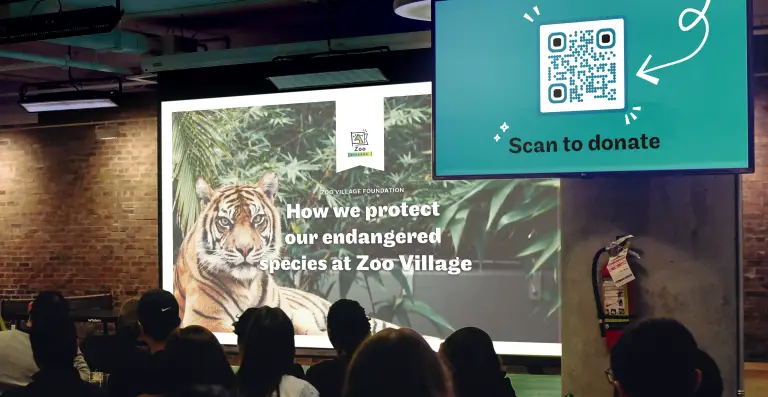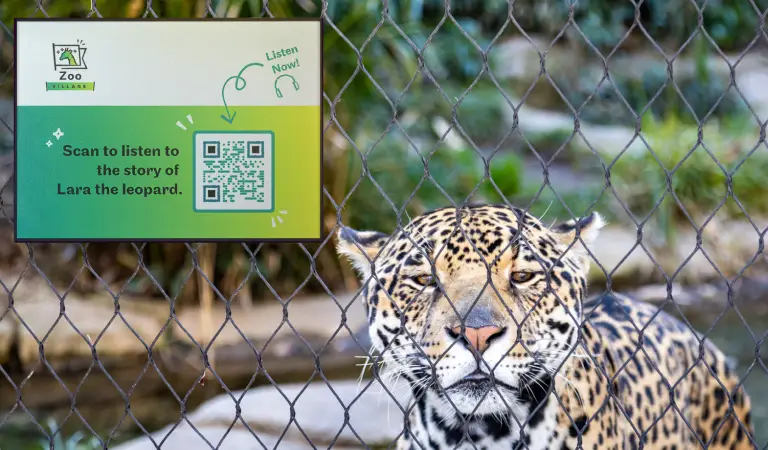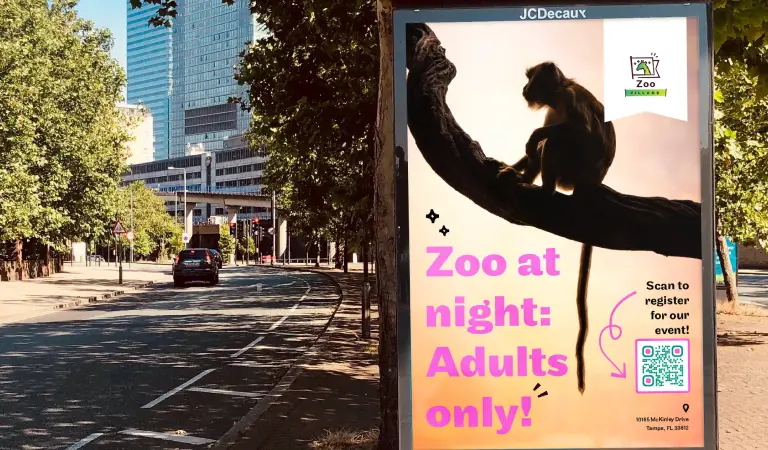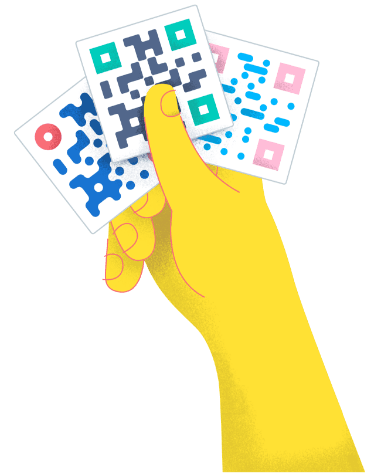- Best Practices ●
- COVID-19 ●
- Industry Trends ●
- Partners ●
- Product ●
5 Engaging Ways to Use a Zoo QR Code at Wildlife Parks
A zoo QR Code is a multifaceted tool used for enhancing zoo experiences for guests. Displaying QR Codes throughout a zoo can connect visitors to online resource hubs, from learning more about animals to bringing in more traffic to the zoo’s online website, and more. Wondering what QR Code technology can do for your wildlife center? Follow along, you’re on the brink of finding out!
-
Table of contents
- Why use a zoo QR Code?
- They’re interactive
- They’re economical
- They’re updatable
- 5 use cases for a zoo QR Code
- #1 Revive your educational signage
- #2 Get more funding for wildlife parks
- #3 Create immersive animal experiences
- #4 Boost social media presence
- #5 Get an influx of zoo attendance
- 3 best practices for using a zoo QR Code at your wildlife park
- #1 Add a call to action
- #2 Personalize your dotted square
- #3 Carve out time for testing
- How to create a zoo QR Code
- Final words
Why use a zoo QR Code?
Is it really necessary to implement a zoo QR Code? Could wildlife facilities benefit from these squiggly squares? If you want to keep a constant stream of visitors in your zoo park and create an even greater, more sustainable home for your animals, square-patterned codes are here to facilitate.
They’re interactive
Zoos aren’t only fun hot spots, they’re also educational environments for curious visitors looking to learn more about wildlife. But keeping attendees of all ages entertained from start to finish is a tiresome job for anyone, even the animals.
With so many QR Code types, you can turn any sign into a source of entertainment or education—and that’s the sweet spot for getting more family, friends, and animal enthusiasts involved. All visitors need to do is use their smartphones to scan the QR Code to interact with online resource hubs about wildlife.
They’re economical
If you value protecting the environment from more damage while saving a buck, then you’ll be pleased to hear that these black and white squares are as cost-effective as they are environmentally friendly.
So instead of printing out hundreds or thousands of materials that would otherwise generate more waste, you could reduce this number by digitizing each printable item with a QR Code solution. Using less paper also prevents littering from occurring in these wildlife centers, protecting the animal sanctuary.
They’re updatable
When you use Dynamic QR Codes, you’ll benefit from being able to edit, change, or update the content of the QR Code whenever you want. This allows you to chop and change the solution without needing to redesign the actual QR Code. Simply put, your square image will stay the same but the solution and content will be different.
5 use cases for a zoo QR Code
Adding a tech component to your wildlife park puts the focus back on those who really matter: the animals. Incorporating a QR Code for zoos can be an invaluable resource for educating people about conservation, reconnecting people with forgotten wildlife, and bringing awareness to the ecosystem. Does your zoo need an upgrade? Take a look at these examples and get inspired!
#1 Revive your educational signage
It’s one thing to create educational signage that has descriptions of the animals, it’s another to make it engaging. But what if you could liven up zoological facts with an interactive sign that caters to young children who can’t read yet? Or what if you could convince the young kid too excited to slow down to stop, pause, and engage with your signage?
If generating interest in the animals and educating visitors is a top priority within your wildlife park, it’s time you trade your old signs in for a tech renovation. QR Codes are here to save the day! Engaging your visitor’s senses with video is a less demanding way of learning, while still keeping the fun meters up!
Want your visitors to learn about the lazy lifestyle of a sloth? Do you hope to broaden your visitor’s minds with rich tales about endangered species? Or do you desire to entertain little kiddos with hilarious or adorable footage of your animals in action?
Simply convert your video content into a Video QR Code and display it on your signage, making it easy to view with smartphones. Bonus: Visitors also have the option of viewing the video content later, etching the memory of the animal in their brains. Once you have a clear vision of why you’re creating a QR Code for zoos, you’ll never stop running out of ideas.

#2 Get more funding for wildlife parks
Some zoo enclosures are rehabilitation centers for wild animals, and some are safe havens for protecting populations of endangered animals. Despite the growing ethical debate on whether zoos are for-profit or for wildlife protection, there are several charities and nonprofit organizations that are advocating for animal conservation.
These organizations depend on the generosity of donors and volunteers to continue their work. A little marketing goes a long way in ensuring that these nonprofit organizations get the funding they need to sustain their animal enclosures.
Need a hand in increasing engagement to expand your donor reach? Using QR Codes for nonprofits is an accessible way to create more awareness around your cause. And just so you know, there are multiple ways to make potential donors more cognizant of animal conservation.
One way would be to conduct a presentation informing visitors about the work you’re currently doing for the animals housed at the zoo. At the end of the presentation, as a call-to-action (CTA), you could display a Dynamic URL QR Code where visitors could either learn more about your organization or even donate on the spot.

#3 Create immersive animal experiences
It’s easy to reduce zoological parks to tourist attractions, where visitors only view animals through the lens of entertainment. But getting people to care about zoo animals as more than spectacles for public display can prove tricky.
One academic project has gathered some fresh insights into how people can foster deeper connections with zoo animals. In this project, a group of scientists conducted an experiment to see how the impact of listening to the sounds of zoo animals impacted the visitor experience.
The results were remarkable. Some participants reported that focusing more on listening helped them pay attention to details they would ordinarily miss at the zoo, while others said they felt a closeness to the animals. Although the results are anecdotal, they unearth profound insights into how sensory input can cultivate deeper connections to one’s environment.
With some effort, you too can create your own soundscape experience in your zoo. All you need to do is record the sounds from the zoo animals in your park and convert them to an MP3 QR Code.
Combining storytelling with the unique sounds of your zoo animals is a great way to invite your visitors into the daily life of a zoo animal. Simply scanning the zoo QR Code can take your visitors on an auditory journey where they can hopefully experience a deeper connection to the animal.

#4 Boost social media presence
Is your zoological park even on the radar without a social media presence? Gone are the days when you could just rely on a steady stream of zoo attendance without putting in any marketing effort. The good news? With a solid social media strategy, you can harness the power of social media to market yourself as a zoo park brand.
Through active social media engagement, you can curate animal content that initiates conversations, builds relationships, and inspires people to share your posts. You can educate by sharing fun facts about endangered animals, infographics about animal habitats, or stories documenting the daily life of the animals at your zoo.
The platform invites your followers to see behind-the-scenes content about your animals that further establish emotional connections with zoo animals outside of opening hours. When you consistently create content and engage with your followers, you can also start campaigns, inspire conservation efforts, and bring awareness to wildlife conservation as a whole.
The best part is that you direct the foot traffic at your zoo to your social media accounts with a single Social Media QR Code. Happy visitors will be thrilled to continue supporting your zoo by scrolling through adorable animal content.

#5 Get an influx of zoo attendance
A zoological park can’t sustain itself without the public. So when zoo attendance starts to wane, then you know it’s time to revamp your strategy. One way is to host different events for varying age groups and purposes.
As much as zoos are child-friendly affairs, parents are often left to the sidelines, chasing after their kids or managing the chaos. This can leave the parent depleted and excluded from the fun. So instead, host some kid-free events for adults so they can spend time roaming around the zoo, without a care in the world.
Another idea would be to create charity events that highlight conservation, or events for school outings, where the zoo becomes the classroom for the day. Need a sophisticated solution to market your events to boost attendance? Trust in the power of square patterned codes.
To create more hype in your zoo, include an Event QR Code on posters or signage around your zoo to get eager visitors to register for your events. By using this simple mobile-friendly solution, scanners can learn about all the details of your event, use a link to purchase their tickets, and save the event on their digital calendars. Voila!

3 best practices for using a zoo QR Code at your wildlife park
Is your brain swirling with new ideas on how to infuse a zoo QR Code at your animal sanctuary? If you answered yes, then here are a few principles to ensure that your dotty black codes make a sensational, lasting impression on your target audience.
#1 Add a call to action
Offer your zoo visitors some guidance on the kind of content they’re about to interact with. It’s also an exciting prospect when they realize there are different kinds of content to engage with as they explore your zoo park. Your CTA needn’t be lengthy. Keep your it short and simple.
#2 Personalize your dotted square
Skip the monochromatic tones and embrace the colors that suit your establishment. You have a full spectrum of colors to choose from. With this in mind, select colors that represent your brand. You can even upload your brand logo, adding it to the middle of the QR Code.
#3 Carve out time for testing
Test your QR Code while you’re still in the creator mode. Before you download, use multiple digital devices to check if your code works, if the landing page is error-free, and whether your code leads to the right content.
How to create a zoo QR Code
- Go to QR Code Generator and sign up for a free trial.
- Select the type of QR Code that is best suited for your wildlife park.
- Fill in all the information on the empty fields about your QR Code.
- Customize the design of the QR Code.
- Test to see if it works.
- Download the QR Code.
- Finally, integrate your pristine square code into your materials!
Final words
Embracing software and marketing solutions like QR Codes gives your zoo a tech-savvy edge. More importantly, it offers animals a platform beyond the boundaries of a zoological park so you can use it to boost conservation efforts in your establishment.
Using a QR Code for zoos invites visitors to engage with wildlife parks in refreshing ways, helping them to foster connections with animals. Ready to get people curious about wildlife or inspire moving campaigns about conservation? Sign up today.






 Add custom colors, logos and frames.
Add custom colors, logos and frames.

